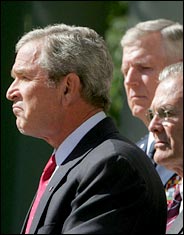Now, with the storms that have trampled Louisiana and Texas having also done historic damage to Gulf of Mexico rigs, I'm a lot more interested.
I haven't heard from the reader in a while (and I'd like to again), but another friend this morning suggested I check out Compass Energy, a Singapore-based firm. Reading Oil & Gas journal this evening, guess what I came across?
Compass Energy buys production semi
By OGJ editors
HOUSTON, Sept. 21 -- Compass Energy Group, an offshore engineering firm based in Singapore, purchased on speculation the semisubmersible production unit Petrobras XXIV to use for fast-track field development and offshore accommodation projects.
The 88-m long production unit was renamed the Molly Brown and is due to arrive in Singapore in mid-November. It was built as a drilling rig by Marathon Le Tourneau in Brownsville, Tex., and named Penrod 72.
In 1987, Placid Oil Co. converted it for use in Green Canyon Block 29 as the Gulf of Mexico's first floating production facility, moored in more than 500 m of water.
The Molly Brown has heated process facilities for up to 60,000 b/d, a gas export system, total power output of 8,000 kw, and accommodation for 94, upgradeable to 200. It does not require any major changes to the hull structure or the marine systems to continue serving as a floating production unit.
There's an old saying: "When there's a will, there's a way." With oil at the incredible prioce of $65 a barrel, let's hope someone in the ERHC/Noble/Pioneer axis has a very strong will.
Anadarko, which won a smaller portion of Block 4, also is going the semi-submersible route, it announced:
Anadarko Announces Rig Plan to Deliver on Deepwater Strategy
Click here for printer friendly version (PDF)
HOUSTON--(BUSINESS WIRE)--Sept. 26, 2005--Anadarko Petroleum Corporation (NYSE:APC) today announced a plan to secure the necessary drilling rigs to execute its deepwater strategy over the next six years.
"A review of our worldwide deepwater drilling inventory along with the tightening deepwater rig market led us to lock in the equipment and services we need to execute upon our strategy," said James T. Hackett, President and CEO. "Nearly two-thirds of the rig time will be to delineate and develop discoveries and the remainder will be for high potential exploration."
As part of the plan, Anadarko with two other producers signed a four-year rig-share agreement under which ENSCO International Incorporated (NYSE:ESV) will build a new semi-submersible drilling rig with a target delivery date of mid-2008. Anadarko committed to 50 percent of the rig time at a cost of almost $200 million over the contract term.
Anadarko executed a three-year drilling contract with Dolphin Drilling Ltd. to secure the Belford Dolphin drillship at a cost of $459 million. It is anticipated the vessel will be released to Anadarko beginning in mid-2007.
In addition, multi-year contracts worth approximately $1.19 billion are being finalized to extend the company's existing contracts and secure incremental rigs. Anadarko currently has two deepwater rigs under contract.
Anadarko's current deepwater Gulf of Mexico development projects include the K2, K2 North and Genghis Khan fields in the Green Canyon area and seven natural gas fields in the Eastern Gulf. Anadarko also has working interests in several non-operated exploration wells currently in progress, including the announced Knotty Head commercial discovery, which will need delineation and development. The company has identified multiple additional prospects throughout the deepwater Gulf and has prospects offshore West Africa, Georgia and Gabon. The company's expanded rig position could provide leverage into additional opportunities if further tightening of the deepwater rig market materializes.
"Our rig-contracting efforts offer compelling economics and facilitate our deepwater drilling strategy. In addition to addressing the cost side of the equation, we will protect our returns by hedging volumes in a manner to cover potential downside rig rates," added Hackett. "While we believe the dynamics of the deepwater rig market over the next six years will be very different than past cycles, we think it prudent to manage potential rig rate risk like we manage other risks -- by controlling the downside and executing upon our operational strategy."

